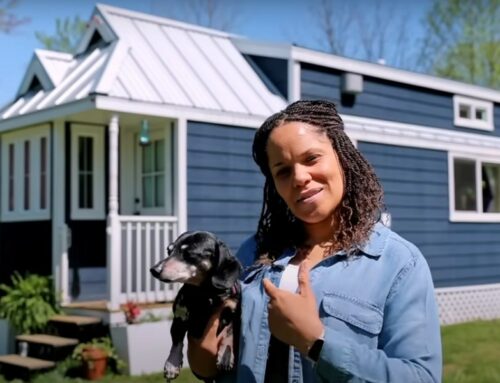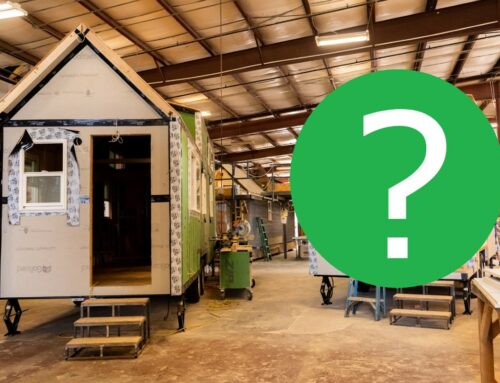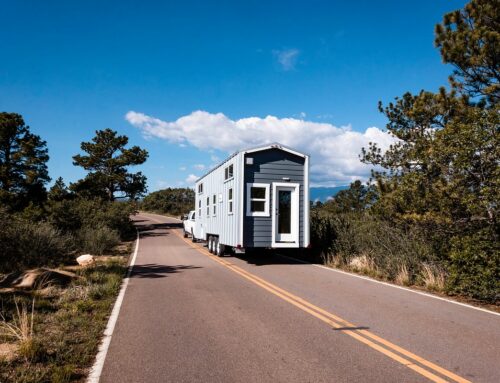When you live in a mobile dwelling, you have to think about your waste. Not just the waste in your trash bin, but also your human waste. Where does it go? How do you deal with it? Does it smell? In this article, I’m going to discuss my composting toilet – the Nature’s Head, which is enormously popular in the Tiny House world. We’re going to get into the dirty details of how to deal with the dung (say that 10 times fast). . . so if you’re squeamish, you may not want to read on. You’ve been warned!
Nature’s Head Composting Toilet
While there are many composting toilets on the market, Nature’s Head is the favorite among Tiny Housers for several reasons.
1). Self-containment. This toilet is completely self-contained and can be installed easily. A vent with a 12-volt fan is necessary for operation, but other than that, it’s ready to go straight out of the packaging.
2). Odorless. This toilet is virtually odorless. I know you probably don’t believe me, but I’ve been using this toilet for three years and I’ve been pleasantly surprised. When it does smell, it’s usually the urine container. More on that later.
3). Ease of Use. As with any composting toilet, Nature’s Head takes some getting used to. Overall, it’s very easy to use, dump, and maintain.
How to use the Nature’s Head Composting Toilet
Nature’s Head separates the liquid waste and solid waste into two different containers. This is why it remains odorless. When you use the toilet, you have to manually open a latch to direct your solid waste into the correct container. Liquid waste automatically drains into the correct container when the latch is closed. All humans must sit to use this toilet (yes, men, you too). All toilet paper goes into the solid waste chamber. There is a crank on the side of the toilet for mixing the solid waste, which should be turned daily.
Pro Tips:
- Use RV toilet paper (1-ply). It breaks down faster. It’s also best to tear a bunch of squares rather than use a long strand of paper. Why? Because the toilet paper will get wrapped around the crank, making turning the solid waste a difficult task. To elongate periods in between dumping, throw toilet paper that is used when going #1 in the trash rather than overloading your solid waste chamber.
- Keep a bottle of water mixed with white vinegar next to the toilet. Spray after each use to “flush.”
- Worms can be used in the toilet. Read more about this here.
Where/How do you dump the contents? How Often?
There are a few ways to dump the toilet, depending on your situation. Below I’ve listed my preferred methods, as well as options for those owning their own land.
Solid Waste
I live alone in my Tiny House RV, so I dump the solid waste every 3-4 months. When I have company, I have to dump more often. The toilet is rated for 90 uses, so you can do the math. Weather also can make a difference in how often I dump, so I rely on the crank to tell me when it’s time to dump. Is it hard to turn? If the answer is yes, it’s time.
I bag my solid waste in a biodegradable trash bag and throw it in the dumpster. This is perfectly legal. People throw human waste (diapers for example) in the garbage every day. You could also start a compost pile if you have land and the area is legally sanctioned for that purpose. Later, after the decomposition process is complete, you could use the compost in your garden.
After emptying, I fill the solid waste container with coconut coir (about half full). There is no need to clean out the solid waste container. In fact, you want to leave the bacteria, as it will help break down new waste.

Liquid Waste
For me, the liquid waste container fills up every 3-4 days (more often if I have guests). I simply dump the contents down the drain in my shower, which is connected to the sewer at my RV park. If you had your own property, you could dilute the urine and use it to water your lawn. A little nitrogen is good for grass. You could also plumb the toilet into your grey water system. This would require drilling another hole in your trailer and some basic plumbing knowledge. If your grey water empties into the sewer, like mine does, you would also need a p-trap to prevent sewer smells from coming back into your Tiny House RV.
After emptying, I rinse the liquid container, fill it with 2 cups of white vinegar (to reduce smells), and place it back in my toilet. If the liquid waste becomes smelly during use, I dilute it by pouring a cup of water into the toilet. Sometimes I also add a tablespoon of sugar. When it comes to urine, it’s all about balancing the acidity levels. I’ve learned a lot over the years through trial and error.
Where to Buy the Nature’s Head
I hope this article has been helpful, and perhaps convinced you that composting toilets are not scary. If you’re ready to buy a Nature’s Head for your Tiny House RV, click here to purchase now.
Would You Use a Composting Toilet?
More articles you might like:
- 8 Off-Grid Appliances for Tiny Housers
- How to make a DIY Compost Toilet
- 3 Manufactured Composting Toilets for Tiny House RVs
Video credit: Art Cormier
Disclaimer: This article has affiliate links. If you purchase through these links, the blogger will receive a small percentage of the small at no extra cost to you.








